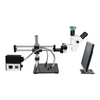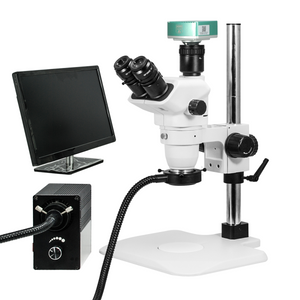Quick Overview
Finite. Total Magnification: 6.7-45X. 10X Adjustable Eyepiece. 1X Built-in Objective. Standard Coupler: 0.5X. Zoom Ratio: 1:6.7. Trinocular. Body Mounting Size for Stand: Dia. 76mm. Eye Tube Angle: 45°. Eyepiece Field of View: Dia. 22mm. Dual Arm Stand. UV FREE LED Light. Light Adjustable. Gooseneck Dual Pipe Light . CMOS. 2.0 Megapixels. HDMI / USB 2.0. Windows XP/7/8/10/11. Screen Size: 21.5in. Input Voltage: AC 90-240V 50/60Hz. Input Voltage: DC 12V. Input Voltage: AC 96-265V 50/60Hz. Use SZ0503 Series Coupler.
SZ02060537 Trinocular Zoom Stereo Microscope
Optical System Specifications
| Optical System | Finite |
| System Optical Magnification | 6.7-45X |
| Expandable System Optical Magnification (Optional Parts Required) | 2-180X |
| Trinocular Optical Magnification | 0.335-2.25X |
| System Electronic Magnification | 29.04-195.04X |
| Total Magnification | 6.7-45X |
| Standard Eyepiece | 10X Adjustable Eyepiece |
| Standard Objective | 1X Built-in Objective |
| Standard Coupler | 0.5X |
| System Field of View | Dia. 4.9-32.8mm |
| Expandable System Field of View | Dia. 1.33-109.5mm |
| System Working Distance | 100mm |
| Expandable System Working Distance | 26-287mm |
Trinocular Zoom Body
| 50/50 True-Trinocular Zoom Body | |
| Body Optical System | Finite |
| Body Magnification | 6.7-45X |
| Zoom Range | 0.67-4.5X |
| Zoom Ratio | 1:6.7 |
| Zoom Operating Mode | With Two Horizontal Knobs |
| Observation Method | Trinocular |
| Body Mounting Size for Stand | Dia. 76mm |
| Body Mount Type for Coupler | Thread Screw |
| Body Mount Size for Coupler | Dia. 38mm |
| Nosepiece Adapter Size for Ring Light | Dia. 54mm |
| Eye Tube Adjustment Mode | Compensating |
| Eye Tube Angle | 45° |
| Erect/Inverted Image | Erect image |
| Eye Tube Rotatable | 360° Degree Rotatable |
| Interpupillary Adjustment | 54-75mm |
| Eye Tube Inner Diameter | Dia. 30mm |
| Eye Tube Fixing Mode | Locking Screw |
| Image Port Switch Mode | 50/50 True-Trinocular |
| Eyepiece Type | Adjustable Eyepiece |
| Eyepiece Optical Magnification | 10X |
| Plan Eyepiece | Plan Eyepiece |
| Eyepiece Size for Eye Tube | Dia. 30mm |
| Eyepiece Field of View | Dia. 22mm |
| Eyepoint Type | High Eyepoint Eyepiece |
| Eyepiece Diopter Correction | ±5° |
| Built-in Objective Magnification | 1X |
| Objective Working Distance | 100mm |
| Objective Screw Thread | M48x0.75mm |
| Surface Treatment | Spray Paint |
| Material | Metal |
| Color | White |
| Net Weight | 1.68kg (3.70lbs) |
| Notes | Use SZ0503 Series Coupler |
Dual Arm Stand
| Dual Arm Boom Stand | |
| Stand Type | Dual Arm Stand |
| Vertical Post Height | 384mm |
| Maximum Vertical Post Extended Length | 254mm |
| Vertical Post Diameter | Dia. 37.2mm |
| Cross Adapter Type | Triple (3) Hole Adapter |
| Horizontal Arm Type | Double Bar |
| Horizontal Arm Length | 570mm |
| Horizontal Diameter | Dia. 20mm |
| Mounting Hole on the Top of Horizontal Arm | 16mm |
| Horizontal Rotation Angle | 360° Degree Rotatable |
| Horizontal Arm Travel Distance on Z-Axis | 282mm |
| Horizontal Arm Stretch Range | 320mm (12.598 in. ) |
| Horizontal Arm Maximum Load | 9.50kg (20.94lbs) |
| Horizontal Arm Travel Mode on Horizontal Direction | Ball Bearing |
| Horizontal Arm Travel Mode on Z Direction | Manual |
| Base Type | Heavy Duty Base |
| Base Shape | Rectangle |
| Base Dimensions | 285x260x18mm |
| Surface Treatment | Electroplating Black |
| Material | Metal |
| Color | Black |
| Net Weight | 18.06kg (39.82lbs) |
| Dimensions | 570x285x405mm (22.441x11.220x15.945 in. ) |
E-Arm
| 76mm E-Arm | |
| Holder Adapter Type | Dia. 76mm Scope Holder |
| Focus Distance | 50mm |
| Coarse Focus Distance per Rotation | 20mm |
| E-Arm Rotation Range on Horizontal Direction | 360° |
| E-Arm Rotation Range on Z Direction | 180° |
| E-Arm Mounting Adapter | 5/8 in. End Adapter |
| Center Distance from E-Arm Adapter to Scope Holder | 130mm |
| E-Arm Horizontal Adjustment Screw | Horizontal Adjustable |
| Safety Protection Against Falling Screw | With Safety protection against falling Screw |
| Surface Treatment | Spray Paint |
| Material | Metal |
| Color | White |
| Net Weight | 0.84kg (1.85lbs) |
Fiber Optic Light Source
| 24W UV Free LED Fiber Optic Illuminator | |
| Light Source Type | UV FREE LED Light |
| Power Supply Adjustable | Light Adjustable |
| Power Box Light Port | Single Hole |
| Fiber Cable Adapter Size | 5/8 in. End Adapter |
| Power Box Panel Meter Display | Pointer Panel Meter/Scale |
| Power Box Cooling System | Fan Cooling system |
| Power Box Dimensions | 185x150x95mm |
| Bulb Color (Wavelength) | UV FREE |
| Output Power | 24W |
| Input Voltage | AC 96-265V 50/60Hz |
| Output Voltage | DC 24V |
| Power Cord Connector Type | USA 3 Pins |
| Surface Treatment | Black Oxide Finish |
| Material | Metal |
| Color | Black |
| Net Weight | 3.20kg (7.05lbs) |
Optical Fiber Light Guide
| 460mm Dual Pipe Light Guide | |
| Optical Fiber Cable Type | Gooseneck Dual Pipe Light |
| Fiber Light Output Port Size | Dia. 5mm |
| Fiber Cable Output Port Adapter Size | Dia. 8mm |
| Fiber Light Input Port Size | Dia. 7mm |
| Fiber Cable Input Port Adapter Size | 5/8 in. End Adapter |
| Pipe Material | Gooseneck Fiber Cable |
| Optical Fiber Cable Length | 460mm |
| Pipe Diameter | Dia. 12.4mm |
| Pipe Color | Silver |
| Flexural Property | Min. Bending Radius ≥30D |
| Fiber Cable Mounting Type | Fastening Screw |
| Fiber Condenser Light Spot Adjustable | Adjustable |
| Material | Metal |
| Color | Silver |
| Net Weight | 0.60kg (1.32lbs) |
Coupler/C-mount Adapter
| 0.5X Coupler | |
| Coupler Mount Type for Trinocular | Fastening Screw |
| Coupler Mount Size for Trinocular | Dia. 38mm |
| Adjustable Coupler | Adjustable |
| Coupler for Microscope Type | Stereo Compatible |
| Coupler Magnification | 0.5X |
| C/CS-Mount Coupler | C-Mount |
| Surface Treatment | Electroplating Black |
| Material | Metal |
| Color | Black |
| Net Weight | 0.10kg (0.22lbs) |
| Applied Field | For SZ0502, SZ0503 Series Trinocular Zoom Body |
HDMI Camera
| 2M HDMI Color Camera | |
| Image Sensor | CMOS |
| Image Sensor Size | 1/2.86 in. |
| Image Sensor Diagonal size | 6.592mm (0.260 in. ) |
| Camera Maximum Pixels | 2.0 Megapixels |
| Camera Resolution | 1920x1080 |
| Camera Signal Output Port | HDMI / USB 2.0 |
| Camera Lens Mount | C-Mount |
| Transmission Frame Rate | 30fps@1920x1080 |
| White Balance | Manual/Auto |
| Gain Control | Adjustable |
| Exposure Control | Manual |
| Image Comparison | Yes |
| Image Freeze Function | Image Freeze |
| Digital Zoom Function | 10X |
| Camera Crosshairs | Cross Line |
| Number of Crosshairs | 4 Movable Crosshairs |
| Line Color | User Defined |
| Capture Function | Yes |
| Image Capture Output Format | Bitmap |
| Video Output Format | AVI |
| Language | English |
| System Requirement | Windows XP/7/8/10/11 |
| Camera Housing Material | Metal |
| Camera Housing Size | 83x74x53mm |
| Camera Housing Color | Blue |
| Memory Type | SD |
| Input Voltage | DC 12V |
| Surface Treatment | Electroplating |
| Net Weight | 0.60kg (1.32lbs) |
Camera Accessories
| 2M HDMI Color Camera | |
| Mouse Operation | Yes |
| Memory Type | SD |
| Memory Capacity | 8G |
TFT-LCD Monitor
| 21.5 in. Color Monitor | |
| Screen Size | 21.5in |
| Screen Aspect Ratio | 16:9 |
| Monitor Input Signal Format | AV/BNC/VGA/HDMI |
| Monitor Signal Format | NTSC/PAL Auto-Switch |
| Monitor Max. Resolution | 1920x1080 |
| Screen Active Area | 475x265mm (18.701x10.433 in. ) |
| Screen Contrast | 800:1 |
| Screen Brightness | 350cd/m2 |
| Response Time | 6ms |
| Screen Refresh Rate | 60-75Hz |
| Screen Viewing Angle | 178°/178° |
| Screen Backlight | LED Display |
| Monitor Operating Temperature | 0℃~65℃ |
| Monitor Housing Material | Plastic |
| Monitor Housing Size | 51x31x4cm |
| Monitor Housing Color | Black |
| Output Power | 36W |
| Input Voltage | AC 90-240V 50/60Hz |
| Output Voltage | DC 12V |
| Power Cord Connector Type | USA 3 Pins |
| Power Cable Length | 1.8m |
| Net Weight | 2.70kg (5.95lbs) |
Other Parameters
| Surface Treatment | Spray Paint |
| Material | Metal |
| Color | White |
| Net Weight | 27.80kg (61.29lbs) |
| Dimensions | 570x285x405mm (22.441x11.220x15.945 in. ) |
Series
| SZ0502 | SZ02060537 |
| Contains | ||||||||||||||||||||||||||||
| Parts Including | ||||||||||||||||||||||||||||
| ||||||||||||||||||||||||||||
| Packing | |
| Packaging Type | Carton Packaging |
| Packaging Material | Corrugated Carton |
| Packaging Dimensions(1) | 36x20x27cm (14.173x7.874x10.630″) |
| Packaging Dimensions(2) | 51x43x18cm (20x17x7″) |
| Packaging Dimensions(3) | 29x16x18cm (11.417x6.299x7.087″) |
| Packaging Dimensions(4) | 28x23x7cm (11.024x9.055x2.756″) |
| Packaging Dimensions(5) | 55x43.5x10.5cm (21.654x17.126x4.134″) |
| Packaging Dimensions(6) | 23x22.5x4cm (9.055x8.858x1.575″) |
| Packaging Dimensions(7) | 25.5x15.5x25.5cm (10.039x6.102x10.039″) |
| Inner Packing Material | Plastic Bag |
| Ancillary Packaging Materials | Expanded Polystyrene |
| Gross Weight | 31.32kg (69.05lbs) |
| Minimum Packaging Quantity | 1pc |
| Transportation Carton | Carton Packaging |
| Transportation Carton Material | Corrugated Carton |
| Transportation Carton Dimensions(1) | 36x20x27cm (14.173x7.874x10.630″) |
| Transportation Carton Dimensions(2) | 51x43x18cm (20x17x7″) |
| Transportation Carton Dimensions(3) | 29x16x18cm (11.417x6.299x7.087″) |
| Transportation Carton Dimensions(4) | 28x23x7cm (11.024x9.055x2.756″) |
| Transportation Carton Dimensions(5) | 55x43.5x10.5cm (21.654x17.126x4.134″) |
| Transportation Carton Dimensions(6) | 23x22.5x4cm (9.055x8.858x1.575″) |
| Transportation Carton Dimensions(7) | 25.5x15.5x25.5cm (10.039x6.102x10.039″) |
| Total Gross Weight of Transportation(kilogram) | 31.32 |
| Total Gross Weight of Transportation(pound) | 69.05 |
| Quantity of One Transportation Carton | 7pc |

































